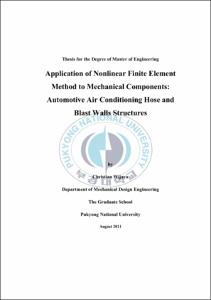Application of Nonlinear Finite Element Method to Mechanical Components: Automotive Air Conditioning Hose and Blast Wall Structures
- Alternative Title
- 기계구성부품에 대한 비선형 유한요소법의 적용: 자동차용 에어컨호스 및 방폭벽체
- Abstract
- In many practical applications, the assumption of linear behavior precludes obtaining an accurate assessment of the solution because of the presence of non-linear effects such as geometry, material and boundary condition nonlinearities. This study presents the use of Nonlinear Finite Element Analysis in some cases regarding to structural analysis. The case study has been divided into two cases. Firstly, the structural analyses of automotive Air Conditioning (A/C) hose highlight the assessment of dynamic characteristics. Secondly, the nonlinear FEA is presented for analyzing the structural design of blast wall subjected to blast loading.
For the automotive A/C hose case, the FE analysis was composed of two categories, the modal and the transient analysis. The dynamic modal analysis was conducted to assess the dynamic characteristics of the A/C hose structure and the dynamic transient analysis was used to investigate the dynamic stresses of automotive A/C hose caused of the dynamic loading. Furthermore, those analyses results are applied to design optimization of hose layout that is related to the constrained design space. The modal testing was undertaken to verify the FE model. The FE result is in good agreement with the experimental results. The modal analysis result shows the bending and swing mode of hose appear in the first ten natural frequencies. The dynamic transient result shows that the maximum stress of hose components occurs in the reinforced braid layers that have taken particular interest with respect to damage accumulation.
In the study of blast wall, this works examine the proposed designs of the corrugated panel in order to determine the best design which satisfies the design criteria by using quasi-static analysis. The maximum deflection and maximum stress criteria were used to decide the best design. The effect of alteration on the profile’s inclined angle was also performed. Moreover, the dynamic analysis on both unstiffened and stiffened corrugated panels subjected to hydrocarbon explosion is presented. A parametric study is also conducted on the simplified models of stiffened corrugated panels considering the contribution of stiffeners on the compression flange under the different loading levels. Furthermore, the ½ symmetry of corrugated panels was modeled. This numerical study was performed using NX. Nastran version 7.5. The results show that the unstiffened panel produces the localized buckling at the centre of corrugation and large permanent deformation with increasing the load. The stiffened panels are able to suppress the response significantly and are structurally more efficient than the unstiffened one.
- Issued Date
- 2011
- Awarded Date
- 2011. 8
- Type
- Dissertation
- Publisher
- Pukyong National University, Department of Mechanical Design Engineering
- Affiliation
- Pukyong National University, Department of Mechanical Design Engineering
- Department
- 산업대학원 기계설계학과
- Advisor
- Byung-Tak Kim
- Table Of Contents
- Contents
Nomenclature
Abstract
I. Introduction 1
1.1 Nonlinear FEM 1
1.1.2 Boundary Condition Non-linearities 3
1.1.3 Material Non-linearities 3
1.2 Objective of the Study 4
1.3 Outline of Thesis 4
1.4 Scientific Contribution 5
References 6
II. Background Knowledge 7
2.1 Basic Concept of Nonlinear FEM 7
2.2 Formulation for Dynamic Analysis 8
2.2.1 Dynamic Modal Analysis 9
2.2.2 Dynamic Transient Analysis 10
2.3 Material Models and Formulations 10
2.3.1 Hyperelastic Material 10
2.3.2 Elastoplastic Material 12
References 13
III. Automotive Air Conditioning Hose Structure 15
3.1 Air Conditioning Hose Used as Automotive Vehicle Part 15
3.2 Finite Element Modeling 16
3.3 Material Properties 18
3.4 Results & Discussions 20
3.4.1 Verification with Modal Testing 20
3.4.2 Result of Dynamic Modal Analysis 23
3.4.3 Result of Dynamic Transient Analysis 26
References 31
IV. Blast Wall Structures 33
4.1 Blast Walls Used in Offshore 33
4.2 FE Analysis for Various Profiles of Blast Walls 34
4.2.1 Simulation Results for Various Profiles of Blast Walls 36
4.2.2 Effect of Inclined Angle 40
4.3 FE Analysis of Unstiffened and Stiffened Corrugated Panels 45
4.3.1 FE Results for Unstiffened Corrugated Panels 49
4.3.2 FE Results for Stiffened Corrugated Panels 52
4.3.3 Comparison for Response of Unstiffened and Stiffened Corrugated Panels 55
References 58
V. Conclusions 60
Acknowledgment 62
- Degree
- Master
- Files in This Item:
-
-
Download
 Application of Nonlinear Finite Element Method to Mechanical Components: Automotive Air Conditioning.pdf
기타 데이터 / 4.63 MB / Adobe PDF
Application of Nonlinear Finite Element Method to Mechanical Components: Automotive Air Conditioning.pdf
기타 데이터 / 4.63 MB / Adobe PDF
-
Items in Repository are protected by copyright, with all rights reserved, unless otherwise indicated.